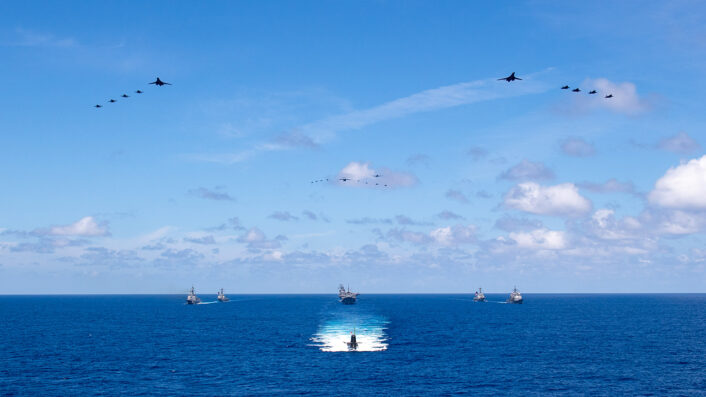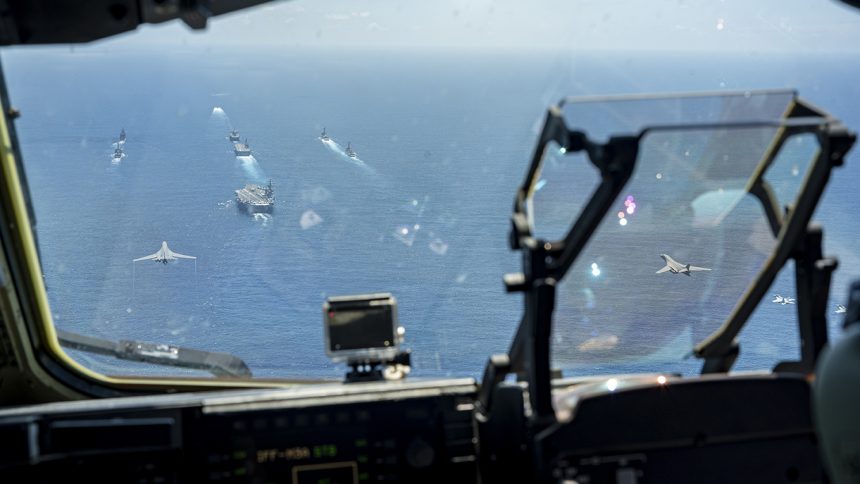U.S. Air Force B-1B Lancer strategic bombers deployed to Andersen Air Force Base in Guam have taken part in a major exercise in the Pacific.
Exercise Valiant Shield 2024, a multinational exercise in the Indo-Pacific region, began on June 7, 2024 with a large display of naval and air power by the United States Navy (USN), United States Air Force (USAF) and the Japan Maritime Self-Defense Force (JMSDF). A fleet of naval vessels, including the aircraft carrier USS Ronald Reagan (CVN 76) and JMSDF helicopter carrier JS Izumo (DDH-183), were overflown by several mixed formations of aircraft from both nations.
Led by two B-1B Lancer strategic bombers from 37th Bomb Squadron at Ellsworth Air Force Base, the USAF also contributed four F-22 Raptors, four F-16 Fighting Falcons, a KC-46A Pegasus and a C-17A Globemaster III for the flypast. With them were two Mitsubishi F-15 Eagles and two Mitsubishi F-2s from the Japan Air Self-Defense Force (JASDF) and four F/A-18E Super Hornets from USN Carrier Air Wing 5, currently attached to the USS Ronald Reagan.

Valiant Shield exercises have been held biennially by the United States military since 2006. 2024 marks the tenth time it has taken place, and the first time that the large-scale exercise has been opened up to international participation. In addition to Japan, forces from France and Canada are contributing to the exercise in the form of ships attached to Carrier Strike Group Nine, led by aircraft carrier USS Theodore Roosevelt (CVN 71), in the South China Sea.
Tensions in the Pacific
The exercise comes at a time of heightened tensions in the Pacific. Cross-border incidents between North Korea and South Korea have featured heavily in recent news. In January North Korean forces fired more than two hundred artillery shells around the disputed maritime border with South Korea, leading to residents on islands close to the border being ordered to take shelter. South Korean forces responded with their own live-fire drills from Yeonpyeong Island. A previous live-fire skirmish in 2010 led to several fatalities on the South Korean island. More recently, in April, North Korea responded to joint US-South Korea military drills with the test launch of a Hwasong-11D ballistic missile.
Then, following a failed satellite launch on May 28, 2024, a series of ten missile firings took place. These were overseen directly by leader Kim Jong Un. An incident at the Korean de-militarized zone (DMZ) took place on June 9 when several North Korean soldiers crossed the official military demarcation line between the two countries carrying assorted tools. Warning shots were fired by South Korean forces and the trespassing soldiers quickly returned to the other side of the border, however this incident has been regarded as an unintentional incursion.
B-1B Lancer aircraft have historically played a central role in US responses to North Korean actions. On June 5, a B-1B joined with F-15K Slam Eagles from the Republic of Korea Air Force (ROKAF) over South Korea and dropped precision-guided GBU-38 Joint Direct Attack Munition (JDAM) weapons in a training exercise over Pilsung Range. South Korean officials acknowledged the exercise as a demonstration of the United States’ commitment to security on the Korean peninsula and the wider region.
Two @USAirForce B-1B Lancers from Andersen AFB, Guam, and two ROKAF F-15K Slam Eagles from Daegu AB conducted live munitions training at Pilsung Range, ROK.
Their precision teamwork and GBU-38 drops tested U.S.-ROK close air support and strike capabilities. pic.twitter.com/NQDf9IUddB
— Department of Defense 🇺🇸 (@DeptofDefense) June 9, 2024
The Lancer fleet was retrofitted in the 1990s to remove its capability to deploy nuclear weapons, meaning it is the only strategic bomber type in the U.S. Air Force to solely carry conventional payloads. This can be an advantage when employing the aircraft for posturing purposes, providing a long range strategic capability without raising any questions regarding the possibility of the aircraft carrying nuclear payloads. A number of the aircraft were forward deployed to Andersen Air Force Base on the US Pacific island territory of Guam in May 2024 as part of a regular series of deployments known as Bomber Task Force missions.
These missions have taken place on a regular basis since 2014, operating B-1B Lancer, B-52H Stratofortress and B-2A Spirit bombers from both Pacific and European forward operating bases. From these bases the deployed crews fly long-distance sorties and work with allied nations across the globe.
Meanwhile, various nations have reported close encounters between their forces and forces from the People’s Republic of China. Royal Netherlands Navy De Zeven Provinciën class frigate HNLMS Tromp (F803) operating in international waters in the East China Sea reported an unsafe situation where the ship and its embarked NH90 helicopter were approached and circled at close distance on June 7 by multiple Chinese aircraft. On June 5 in the Yellow Sea the Royal Australian Navy air warfare destroyer HMAS Hobart (DDG 39) deployed its MH-60R Seahawk helicopter in response to approaching J-10 fighter aircraft of the People’s Liberation Army Air Force (PLAAF). The PLAAF jet proceeded to release flares around 300 metres ahead of the Seahawk helicopter.
In the South China Sea, vessels belonging to the Philippines were “harassed” and damaged by Chinese Coast Guard ships in late April while en route to assist fishing boats around Scarborough Shoal. Scarborough Shoal falls within the Philippines’ exclusive economic zone (EEZ) but is claimed by the People’s Republic of China, and is one of the focal points for the fierce and ongoing territorial disputes in the South China Sea.









